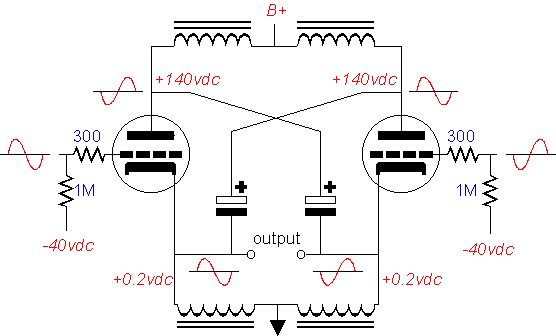I got the inspiration for this Circlotron circuit from John Broskie's website: Tube Cad Journal. My version is a cascoded, balanced pair with center tapped chokes on both ends of the power supply. It seems to sim OK. Would love some input.
Attachments
It's an interesting balanced amp, but there is no "circle" in it, it's not a circlotron 😉
You got just one PS and it's ground-referenced. Circlotron is basically a balanced push-pull with load across the bridge (as in Wien bridge, not as in "bridged amp"). Like this:
You got just one PS and it's ground-referenced. Circlotron is basically a balanced push-pull with load across the bridge (as in Wien bridge, not as in "bridged amp"). Like this:
Attachments
Last edited:
I'll find article tonight after work. The large coupling caps become the second PS according to John's reasoning.
Yes, I do plan to build upon this concept. I already have constructed a balanced, cascoded mosfet/power jfet amp similar in design minus the top choke and coupling caps. Basically, all I need to do is add the choke and caps and I'm in-like-flint.
In my sims I noticed that it's very important to have a small value resistor on the lower choke center tap. The LU1014Ds would fry otherwise. Also, a couple volts from a negative power supply seem to improve the wattage curve on the jfets.
What's cool is that it'll drive a 2 ohm load and deliver 100 watts, or more, in the process.
BTW, I should mention: the mosfets count must be quadrupled at a minimum.
Oh, and it takes 10 volts on the inputs to achieve 120 watts output.
In my sims I noticed that it's very important to have a small value resistor on the lower choke center tap. The LU1014Ds would fry otherwise. Also, a couple volts from a negative power supply seem to improve the wattage curve on the jfets.
What's cool is that it'll drive a 2 ohm load and deliver 100 watts, or more, in the process.
BTW, I should mention: the mosfets count must be quadrupled at a minimum.
Oh, and it takes 10 volts on the inputs to achieve 120 watts output.
Last edited:
I just noticed that I used the incorrect value resistors on the inputs/ground resistor. They should read 100k, not 100. Also, if the mosfet count is increased, they should receive 0.1 ohm resistors at their source pins to insure proper current sharing.
It is not that by the time you spend enough money to get reasonable chokes and PSU caps, you could also have used the same money for two floating Tx and caps, etc. ?
Patrick
Patrick
I have 8 custom wound chokes from Hammond for this exercise: 50 amp; 300 mh. They're probably the greater expense. Please, let's be positive, my friend. This is DIY, and most of what I do is for the satisfaction of the quest.
.... This is DIY, and most of what I do is for the satisfaction of the quest.
Go, woody, go

So I had a closer look this afternoon and did some quick sums.
Assuming we build a power amp with Iq = 4A (no pont building circlotron pre's), and we allow the caps to drop voltage by say 0.3V at 10Hz half cycle. We would need somthing like 0.7F of capacitance for each half. The chokes are then not too bad with such an amount of capacitance. Probably 3mH will do fine. I would guess 2 caps 1F 24V to be around USD400, plus 4 chokes at about the same price (DCR < 0.05ohm).
I guess I can either buy many 24V 100aH car batteries for that price, or separate 1kVA transformers, ..., etc. Maybe useful for tube guys, but this is the Pass forum -- Class A MOSFETs at high bias.
Still, the idea is clever, one has to admit. 😉
Patrick
Assuming we build a power amp with Iq = 4A (no pont building circlotron pre's), and we allow the caps to drop voltage by say 0.3V at 10Hz half cycle. We would need somthing like 0.7F of capacitance for each half. The chokes are then not too bad with such an amount of capacitance. Probably 3mH will do fine. I would guess 2 caps 1F 24V to be around USD400, plus 4 chokes at about the same price (DCR < 0.05ohm).
I guess I can either buy many 24V 100aH car batteries for that price, or separate 1kVA transformers, ..., etc. Maybe useful for tube guys, but this is the Pass forum -- Class A MOSFETs at high bias.
Still, the idea is clever, one has to admit. 😉
Patrick
With 300 mH chokes and 100,000 uF caps my simulator shows a successful outcome. Thanks a bunch for the input. I can't wait to experiment.
Just got home from work and ran sims from 20hz to 20k. I'm getting the same wattage output across the spectrum. I'm not certain why you think I need such a whooping amount of capacitance.
Power supply ripple? I can alway hook up one of Nelson's lovely little Zen V-3 voltage regulators to the supply's positive input (at the positive voltage choke's center tap).
As long as you are happy, that is all that counts.
😉
Patrick
PS Yes, I shall stick to my floating supplies.
😉
Patrick
PS Yes, I shall stick to my floating supplies.
![IMGDEAD]](/community/proxy.php?image=http%3A%2F%2F%5BIMGDEAD%5Dhttp%3A%2F%2Fi48.tinypic.com%2F24xe521.jpg%5B%2FIMGDEAD%5D&hash=d37dc173e3b59a452f825647fcf13fe1)
If you want to build a inductorloaded circlotron you could build this one.
Its an old design of mine. I build one 2005 and it worked realy good.
The inductor is a bifilare winded big E-core transformer with about 2 x 150 turns of 2,5 mm2 isolated coppercable.
With 2 x 15 volt powersupplies i could get 30 watts out of it. (probably more but i couldent measure it that acuratly)
Johannes.
Last edited:
- Status
- Not open for further replies.
- Home
- Amplifiers
- Pass Labs
- Inductor Circlotron


